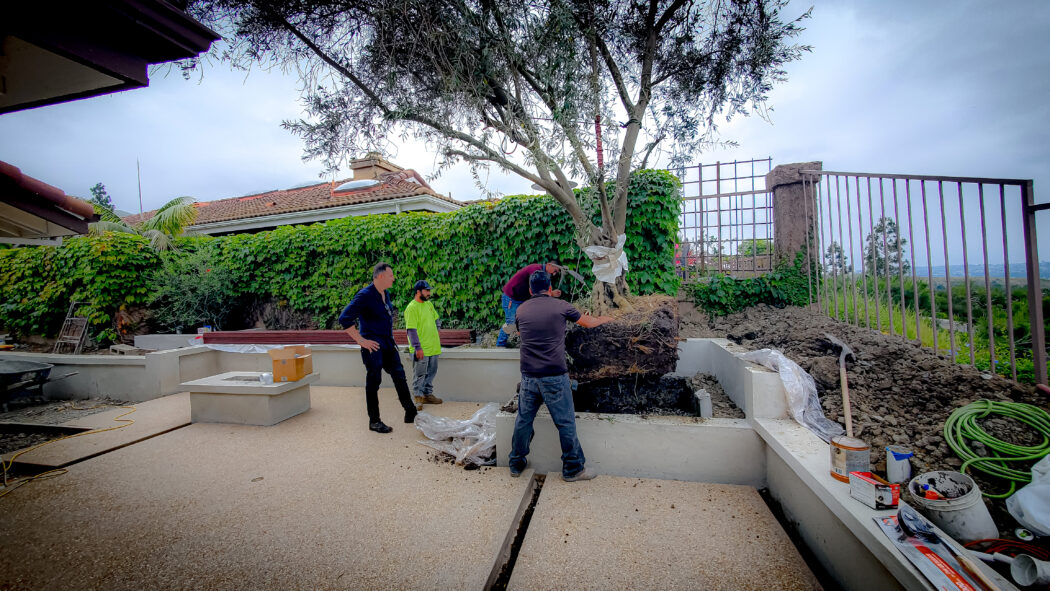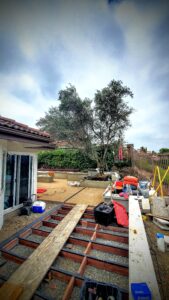Hand-Picking the Perfect Tree
Specific Requirements
When it comes to landscape design, the selection of a focal tree is a crucial decision that can significantly influence the overall aesthetic and functionality of the outdoor space. For our San Juan Capistrano project, we were tasked with finding a tree that not only met specific aesthetic criteria but also served practical purposes.
Project Example: San Juan Capistrano Job
In this particular project, our client desired a centerpiece that would stand out while blending seamlessly with the existing landscape. After careful consideration, we decided on a multitrunk, non-fruiting olive tree. This choice was driven by several key factors:
- Desired Features: The client wanted a tree that exuded stateliness and grandeur. The multitrunk structure provided a unique and striking visual element that a single trunk tree could not offer. Additionally, opting for a non-fruiting variety ensured that maintenance would be minimal, avoiding the mess and upkeep associated with fruit-bearing trees.
- Tree Attributes: Size and origin were paramount in our decision-making process. We sought a large, mature tree that would make an immediate impact upon installation. Field-grown trees, as opposed to nursery-grown ones, typically have a more robust root system and natural growth patterns, making them an ideal choice for a quick and successful establishment in their new environment.
Functionality
Beyond its visual appeal, the chosen olive tree needed to fulfill specific functional requirements:
- Natural Canopy: One of the primary purposes of this tree was to create a natural canopy over the sitting area in the yard. The multi-trunk structure and expansive foliage of the olive tree were perfect for providing ample shade, creating a comfortable and inviting outdoor living space.
- Privacy: Another crucial aspect was to ensure the tree acted as a natural barrier, enhancing privacy by pulling away from the neighboring yard. The dense, lush foliage of the olive tree served this purpose well, adding a layer of seclusion without the need for artificial screens or fences.
By carefully considering these factors and hand-picking the perfect tree, we ensured that the focal point of the San Juan Capistrano project was not only visually stunning but also highly functional, meeting the client’s needs and enhancing the overall landscape design.
The Selection Process
Criteria for Selection
Selecting the right focal tree is a meticulous process that requires a deep understanding of the project’s specific needs and the inherent qualities of various tree species. Here’s how we approached the selection for the San Juan Capistrano project:
- Aesthetics: The visual appeal of the tree was paramount. We needed a tree that not only stood out on its own but also complemented the existing landscape design. The multitrunk olive tree, with its graceful and stately presence, was the perfect match, providing an eye-catching focal point that enhanced the beauty of the yard.
- Growth Habit: Understanding the growth habits of the tree was essential. We needed a tree that would maintain its form and structure as it matured. The olive tree’s slow, steady growth and its ability to develop a broad canopy made it ideal for creating the desired natural canopy over the sitting area.
- Maintenance Needs: Long-term maintenance is a critical consideration in tree selection. We chose a non-fruiting olive variety to minimize the upkeep required. This ensures that the tree remains an asset rather than a burden, providing beauty without excessive maintenance.
Field Visits
To ensure we selected the perfect tree, we conducted several field visits to inspect potential candidates:
- Inspection: During our field visits, we closely examined each tree for health, shape, and size. We looked for trees with a strong, well-developed root system, a balanced structure, and no signs of disease or pest infestation. The chosen olive tree stood out with its robust health and ideal form.
- Decision Making: After thorough inspection and evaluation, we finalized our choice based on the project requirements. The selected multitrunk olive tree met all our criteria, promising both immediate visual impact and long-term benefits.
Site Preparation
Once the perfect tree was selected, preparation for its installation began:
- Site Assessment: We ensured the planting site was adequately prepared, considering factors such as soil quality, drainage, and space for the tree’s root system to expand.
- Crane Setup: Given the tree’s size, we arranged for a crane to facilitate its installation. The crane setup was planned meticulously to ensure a smooth and efficient process.
By adhering to these rigorous selection and preparation processes, we ensured that the chosen focal tree would thrive in its new environment, providing the desired aesthetic and functional benefits to the San Juan Capistrano project.
Installation Day – Crane Operation
Preparation
Installation day is a critical phase in the process of integrating a focal tree into a landscape. Proper preparation ensures that everything proceeds smoothly and safely:
- Site Assessment: Before the tree’s arrival, we conducted a thorough site assessment to confirm that the location was ready for planting. This involved checking soil conditions, ensuring adequate space for the tree’s root system, and verifying that the area was free of obstructions that might hinder the installation process.
- Crane Setup: Given the size and weight of the field-grown olive tree, using a crane was essential. We carefully positioned the crane to ensure it could safely lift and transport the tree to its designated spot in the yard. The setup was planned to minimize disruption to the surrounding landscape and ensure the safety of all personnel involved.
Installation Process
The actual installation process involves several critical steps to ensure the tree is correctly and securely planted:
- Proper Placement: With the crane in position, we carefully lifted the olive tree and maneuvered it into place. This required precision to ensure the tree was positioned exactly where it was needed to provide the desired canopy and privacy.
- Vertical Positioning: Ensuring the tree was perfectly vertical was crucial for both aesthetics and stability. We used levels and guide ropes to adjust the tree’s alignment, making sure it stood upright and secure.
- Alignment and Adjustment: Once the tree was in place, we made fine-tuning adjustments to its position. This involved rotating and aligning the tree to ensure its best side faced the primary viewing areas, maximizing its visual impact.
Securing the Tree
After achieving the perfect placement and alignment, we took steps to secure the tree and promote its long-term health and stability:
- Stabilization: Depending on the species and size of the tree, we use guy wires and stakes to stabilize the tree, preventing it from shifting or tilting as it settled into its new environment. These supports will remain in place until the tree establishes a strong root system.
- Watering and Mulching: To help the tree acclimate to its new surroundings, we provided deep watering and applied a layer of mulch around the base. This helps retain moisture, regulate soil temperature, and protect the roots.
The Final Product
The culmination of our careful planning and meticulous installation process is a beautifully planted focal tree that enhances the overall landscape:
- Immediate Impact: The olive tree immediately transformed the yard, providing a stunning focal point that drew the eye and created a sense of grandeur.
- Functional Benefits: The natural canopy offered by the tree provided much-needed shade over the sitting area, making it a comfortable and inviting outdoor space. Additionally, the tree served as a visual barrier, enhancing privacy from the neighboring yard.
By ensuring proper placement, alignment, and stabilization, we not only achieved a visually striking installation but also set the stage for the tree’s long-term success, contributing to the overall beauty and functionality of the landscape.
The Final Product
Immediate Impact
The successful installation of the multitrunk olive tree marked a significant transformation in the San Juan Capistrano yard. The tree immediately commanded attention, becoming a striking focal point that elevated the entire landscape:
- Visual Appeal: The tree’s stately presence and unique multitrunk structure created a stunning visual centerpiece. Its lush, green foliage contrasted beautifully with the surrounding plants and hardscapes, adding depth and texture to the yard.
- Functional Benefits: Beyond its aesthetic value, the olive tree provided essential functional benefits. The expansive canopy offered ample shade, making the sitting area more comfortable and enjoyable. Additionally, the tree’s placement helped create a natural barrier, enhancing privacy from neighboring properties and contributing to a sense of seclusion and tranquility.
Long-Term Benefits
The benefits of selecting and properly installing a focal tree extend far beyond the immediate impact. Over time, the tree will continue to enhance the landscape in several ways:
- Mature Growth: As the tree grows and matures, its canopy will expand, providing even more shade and creating a more substantial visual anchor in the landscape. The tree’s growth will further integrate it into the yard, making it look as if it has always been a part of the setting.
- Overall Design Harmony: The olive tree’s timeless beauty will continue to complement and enhance the overall landscape design. Its presence will help unify various elements of the yard, creating a cohesive and harmonious outdoor space.
Client Satisfaction
Client feedback is a crucial measure of success for any project. In the case of the San Juan Capistrano installation, the client’s response was overwhelmingly positive:
- Positive Responses: The client expressed great satisfaction with the tree selection and installation process. They were particularly impressed with how the tree transformed their yard, providing both aesthetic and functional benefits.
- Enhanced Enjoyment: The new focal tree significantly increased the client’s enjoyment of their outdoor space. The shade provided by the tree made the sitting area more usable and inviting, while the added privacy allowed them to relax and entertain guests with greater comfort.
Conclusion
The installation of the multitrunk olive tree in the San Juan Capistrano project exemplifies the importance of choosing the right focal tree. By carefully selecting and properly installing the tree, we were able to create a beautiful, functional, and harmonious landscape that met the client’s needs and exceeded their expectations.
For anyone looking to enhance their outdoor space, investing in the right focal tree can make all the difference. At Abode Landscaping, we take pride in our meticulous selection and installation process, ensuring that each project achieves the desired aesthetic and functional outcomes. Reach out to us for expert advice and services to transform your landscape with the perfect focal tree.






